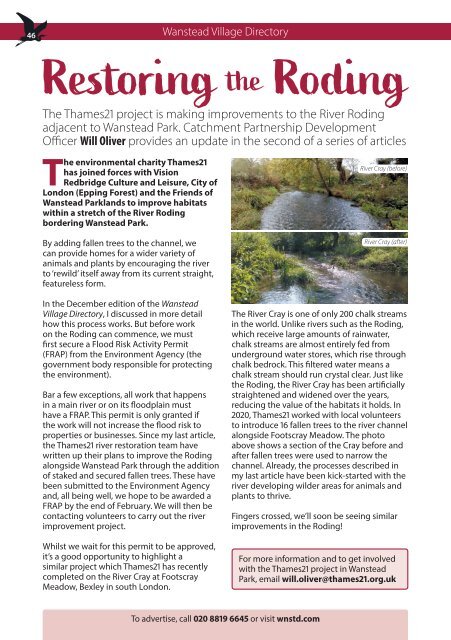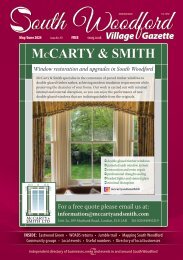February 2022
You also want an ePaper? Increase the reach of your titles
YUMPU automatically turns print PDFs into web optimized ePapers that Google loves.
46<br />
Wanstead Village Directory<br />
Restoring the Roding<br />
The Thames21 project is making improvements to the River Roding<br />
adjacent to Wanstead Park. Catchment Partnership Development<br />
Officer Will Oliver provides an update in the second of a series of articles<br />
The environmental charity Thames21<br />
has joined forces with Vision<br />
Redbridge Culture and Leisure, City of<br />
London (Epping Forest) and the Friends of<br />
Wanstead Parklands to improve habitats<br />
within a stretch of the River Roding<br />
bordering Wanstead Park.<br />
By adding fallen trees to the channel, we<br />
can provide homes for a wider variety of<br />
animals and plants by encouraging the river<br />
to ‘rewild’ itself away from its current straight,<br />
featureless form.<br />
In the December edition of the Wanstead<br />
Village Directory, I discussed in more detail<br />
how this process works. But before work<br />
on the Roding can commence, we must<br />
first secure a Flood Risk Activity Permit<br />
(FRAP) from the Environment Agency (the<br />
government body responsible for protecting<br />
the environment).<br />
Bar a few exceptions, all work that happens<br />
in a main river or on its floodplain must<br />
have a FRAP. This permit is only granted if<br />
the work will not increase the flood risk to<br />
properties or businesses. Since my last article,<br />
the Thames21 river restoration team have<br />
written up their plans to improve the Roding<br />
alongside Wanstead Park through the addition<br />
of staked and secured fallen trees. These have<br />
been submitted to the Environment Agency<br />
and, all being well, we hope to be awarded a<br />
FRAP by the end of <strong>February</strong>. We will then be<br />
contacting volunteers to carry out the river<br />
improvement project.<br />
Whilst we wait for this permit to be approved,<br />
it’s a good opportunity to highlight a<br />
similar project which Thames21 has recently<br />
completed on the River Cray at Footscray<br />
Meadow, Bexley in south London.<br />
River Cray (before)<br />
River Cray (after)<br />
The River Cray is one of only 200 chalk streams<br />
in the world. Unlike rivers such as the Roding,<br />
which receive large amounts of rainwater,<br />
chalk streams are almost entirely fed from<br />
underground water stores, which rise through<br />
chalk bedrock. This filtered water means a<br />
chalk stream should run crystal clear. Just like<br />
the Roding, the River Cray has been artificially<br />
straightened and widened over the years,<br />
reducing the value of the habitats it holds. In<br />
2020, Thames21 worked with local volunteers<br />
to introduce 16 fallen trees to the river channel<br />
alongside Footscray Meadow. The photo<br />
above shows a section of the Cray before and<br />
after fallen trees were used to narrow the<br />
channel. Already, the processes described in<br />
my last article have been kick-started with the<br />
river developing wilder areas for animals and<br />
plants to thrive.<br />
Fingers crossed, we’ll soon be seeing similar<br />
improvements in the Roding!<br />
For more information and to get involved<br />
with the Thames21 project in Wanstead<br />
Park, email will.oliver@thames21.org.uk<br />
To advertise, call 020 8819 6645 or visit wnstd.com

















